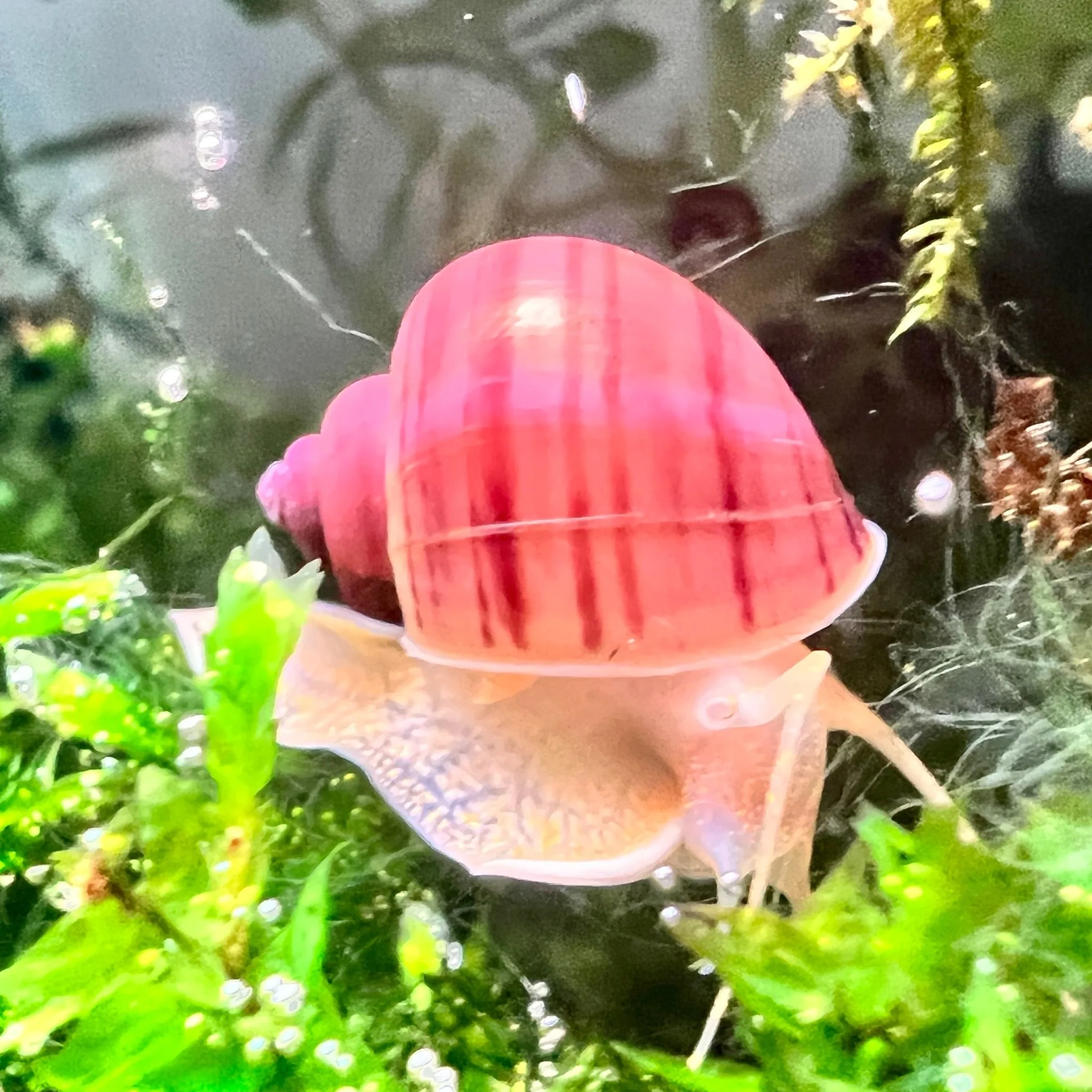Discover the captivating world of mystery snails! Learn about their care, colors, sizes, behavior, and how to identify fertile eggs. Explore the essentials for creating a thriving freshwater aquarium habitat for these unique and fascinating creatures.
In the intricate tapestry of aquatic life, few creatures possess the captivating mystique of the Mystery Snail (Pomacea spp.). With its graceful gliding movements, vibrant shell colors, and enigmatic behaviors, this freshwater gastropod has captured the curiosity of hobbyists, scientists, and nature enthusiasts alike. In this article, we delve into the fascinating world of Mystery Snails, exploring their biology, habitat, behavior, and their growing popularity within aquariums.
A Multicolored Marvel: The Appearance of Mystery Snails
One of the most striking features of Mystery Snails is undoubtedly their shells. Available in an array of colors ranging from golden to blue and even purple, these gastropods exhibit a visually stunning diversity. The intricately spiraled shells provide both protection and an alluring aesthetic, making them a sought-after addition to aquariums.
Habitat and Distribution
Mystery Snails are native to various regions of South America, including countries like Brazil, Argentina, and Bolivia. They are often found in slow-moving bodies of water such as ponds, rivers, and marshes. Their adaptability to a range of aquatic environments has contributed to their widespread distribution and popularity among aquarists.
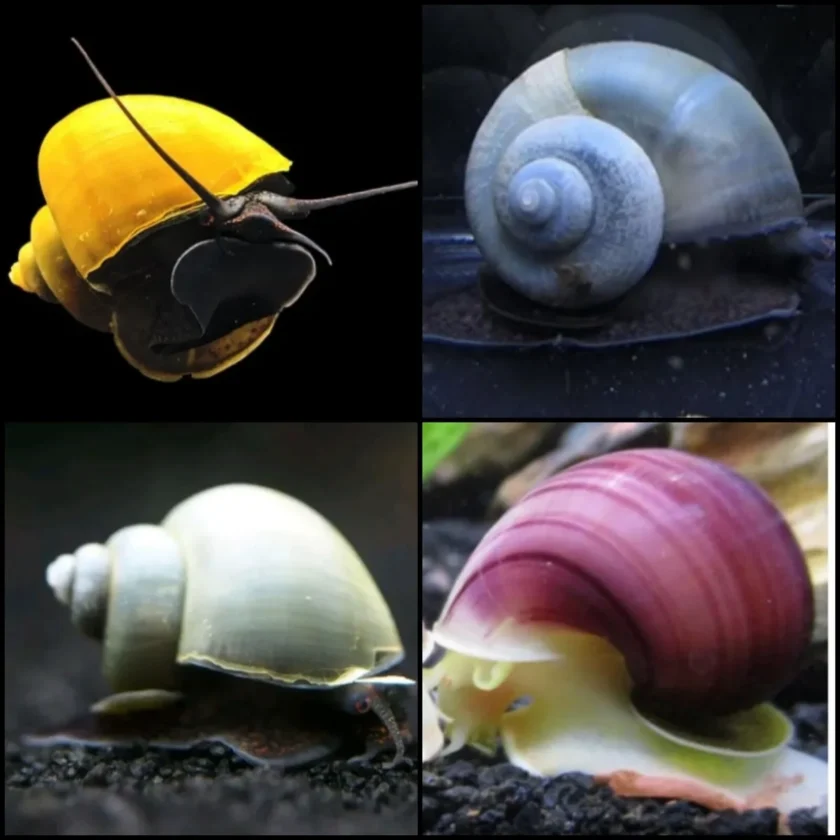
A Mysterious Lifestyle: Behavior and Feeding
True to their name, Mystery Snails exhibit behavior that often leaves observers intrigued. They are known for their intriguing ability to break the water’s surface and breathe air, thanks to a specialized lung-like structure. This enables them to survive in habitats with fluctuating water levels.
Mystery Snails are primarily herbivores, feeding on algae and plant matter. This characteristic makes them beneficial additions to aquariums, as they aid in maintaining a balanced ecosystem by controlling algae growth.
Life in Captivity: Aquarium Enchantment
The allure of Mystery Snails extends beyond their natural habitats. These snails have gained considerable popularity within the aquarium hobby due to their ease of care and unique characteristics. Their peaceful demeanor makes them compatible with a variety of tankmates, from fish to other invertebrates. Additionally, their remarkable ability to lay distinctive clutches of eggs above the waterline adds an element of intrigue for aquarists.
Breeding and Reproduction
Breeding Mystery Snails can be a rewarding experience for aquarium enthusiasts. They are known for their distinctive reproductive behavior, which involves the snails laying clusters of eggs above the waterline. This behavior reduces the chances of aquatic predators consuming the eggs and contributes to the snails’ survival. Raising the tiny snails that hatch from these eggs provides a unique insight into their life cycle.
Conservation Considerations
While Mystery Snails are popular in the aquarium trade, it’s important to remember their natural habitats and conservation needs. Over-collection from the wild can negatively impact local populations. Responsible sourcing and breeding practices are crucial to ensuring the long-term health of these captivating creatures and their ecosystems.

Mystery Snails Eggs
Mystery snails (Pomacea diffusa), also known as apple snails, are popular freshwater aquarium snails known for their interesting behavior, unique appearance, and ability to lay distinctive egg clutches. Here’s some information about mystery snail eggs:
- Egg Clutch Appearance: Mystery snails lay their eggs above the waterline, typically on the walls of the aquarium, decorations, or even on the aquarium lid. The eggs are laid in clusters that resemble small bubbles. These clusters are usually round and range in color from pale pink to brown. They are about the size of a pea or slightly larger.
- Hatching Time: The eggs of mystery snails are relatively hardy and can withstand a certain degree of drying out. This is why they’re laid above the waterline. The hatching time can vary based on factors like temperature, humidity, and water conditions. It typically takes around 2 to 4 weeks for the eggs to hatch. During this time, the eggs may change color and become darker.
- Hatching Process: When the eggs are ready to hatch, the tiny snails will emerge from the egg mass. They often drop into the water below and begin their life in the aquatic environment. It’s important to ensure that there is a way for the baby snails to safely drop into the water, as they can be harmed if they fall from too great a height.
- Caring for Baby Snails: Once the baby snails have hatched and are in the water, they will need suitable food and a safe environment. Providing algae, plant matter, and specialized snail or algae wafers can help them grow. Ensure that water parameters are suitable for their growth and that they have plenty of hiding spots to avoid being eaten by larger tank inhabitants.
- Population Control: Mystery snails are known for their prolific breeding habits, and if conditions are right, they can lay numerous egg clutches. If you don’t want a large population of mystery snails in your aquarium, you can manually remove and dispose of egg clutches. Be sure to handle the eggs gently, as they are delicate and can be easily damaged.
- Sexual Dimorphism: Mystery snails are gonochoristic, meaning they have separate sexes. However, it can be difficult to distinguish between male and female snails based on external appearance alone. Males tend to have a slightly smaller and more pointed aperture (opening) compared to females. In some cases, females might appear larger due to their rounder shells, but this isn’t a foolproof method of sex determination.
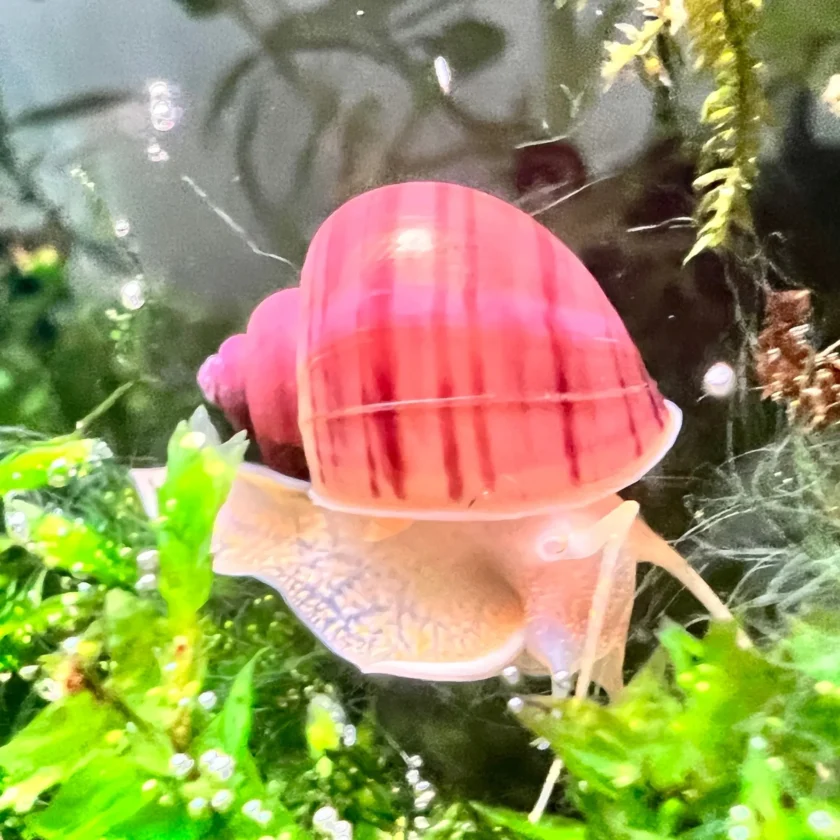
Food and Diet
Mystery snails are primarily herbivores, and their diet consists mainly of plant matter and algae. Providing a balanced and nutritious diet is essential for their health and well-being. Here are some food options for mystery snails:
- Algae and Vegetation: Mystery snails love to graze on algae and various types of aquatic plants. Make sure your aquarium has a good supply of live plants, as well as surfaces with algae growth. This will allow the snails to naturally graze and forage for their food.
- Algae Wafers: Algae wafers are commercially available snail food that provide a concentrated source of plant matter and nutrients. These wafers are designed to sink, allowing snails to feed on them. Look for high-quality algae wafers with a variety of plant-based ingredients.
- Blanched Vegetables: You can offer blanched (briefly boiled and then cooled) vegetables to your mystery snails. Vegetables like zucchini, spinach, lettuce, and cucumber are good options. Attach a vegetable slice to a feeding clip or weigh it down with a small rock, so it stays submerged in the water.
- Spirulina Pellets: Spirulina-based pellets are another suitable option for mystery snails. Spirulina is a type of algae rich in nutrients and is often used in fish and invertebrate diets.
- Calcium Sources: Mystery snails require calcium to maintain healthy shell growth. Providing a source of calcium is important. You can use cuttlebone (a natural source of calcium) or specialized calcium supplements designed for snails and crustaceans.
- Avoid Overfeeding: While mystery snails have a hearty appetite, it’s important not to overfeed them. Excess food can lead to water quality issues and contribute to algae blooms. Feed only as much as they can consume within a few hours, and remove any uneaten food promptly.
- Variety: Like all animals, variety in their diet is beneficial. Try to offer a mix of fresh vegetables, commercial snail food, and natural algae sources to ensure they receive a balanced diet.
Lifespan of Mystery Snails
The lifespan of mystery snails (Pomacea diffusa), also known as apple snails, can vary based on a range of factors, including their environment, care, genetics, and overall health. On average, mystery snails can live anywhere from 1 to 3 years in captivity, although some individuals may live longer under optimal conditions.
Factors that can influence the lifespan of mystery snails include:
- Water Quality: Good water quality is crucial for the health and longevity of mystery snails. Ammonia, nitrite, and nitrate levels should be kept in check, and regular water changes are essential.
- Diet: Providing a balanced and nutritious diet is important. A diet rich in plant matter, algae, and calcium sources (for shell health) contributes to the overall health of the snails.
- Tank Size: The size of the aquarium matters. In a larger, well-maintained tank with ample space and resources, mystery snails tend to thrive better.
- Temperature and Humidity: Mystery snails are tropical animals, so maintaining the appropriate water temperature and humidity levels is important. Keep the water temperature within the range of 68°F to 82°F (20°C to 28°C).
- Calcium Availability: Adequate calcium availability is necessary for shell health. Provide sources of calcium, such as cuttlebone or specialized supplements, to support proper shell growth.
- Companions and Predators: The presence of other tank inhabitants can affect the snails’ lifespan. Aggressive or predatory species may harm or stress the snails.
- Genetics: Genetics play a role in determining how long a mystery snail will live. Some individuals might have stronger genetic predispositions to longer lifespans.
- Stress and Handling: Handling mystery snails excessively or roughly can cause stress and potentially lead to a shorter lifespan.
It’s worth noting that mystery snails are gonochoristic, meaning they have distinct male and female sexes. Females tend to live slightly longer than males due to the energy expended during the reproductive process.
Providing optimal care and a suitable environment can help ensure that your mystery snails have the best chance of living a full and healthy life. Regular observation, water testing, and meeting their dietary and environmental needs will contribute to their well-being and longevity.
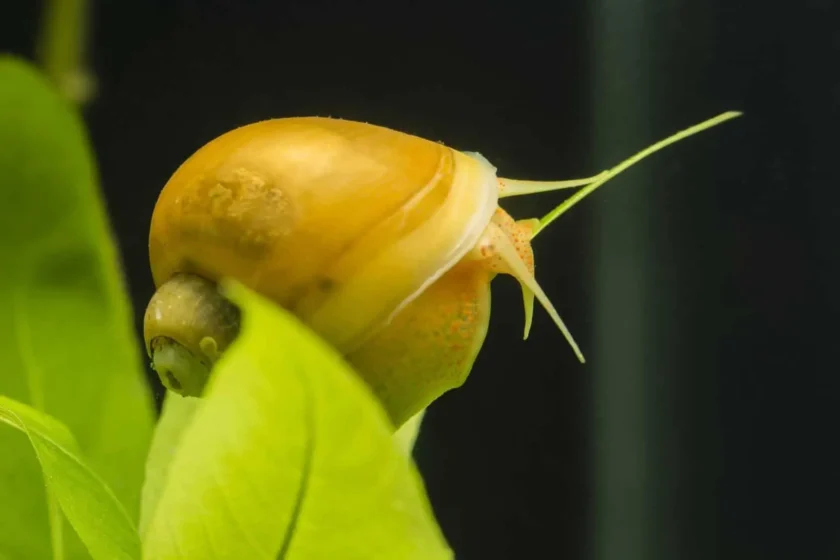
Care Of Mystery Snails
Mystery snails (Pomacea diffusa), also known as apple snails, are popular freshwater aquarium inhabitants. Proper care is essential to ensure their health and well-being. Here’s a guide to mystery snail care:
1. Tank Setup:
- Tank Size: Provide a tank of at least 5 gallons for a single mystery snail. Larger tanks are even better, as they offer more space and stability.
- Substrate: Use smooth gravel or sand as the substrate to prevent damage to the snail’s delicate foot.
- Decoration: Provide hiding places, caves, and plants. Live plants not only provide hiding spots but also serve as a source of food and help maintain water quality.
2. Water Conditions:
- Temperature: Keep the water temperature between 68°F and 82°F (20°C to 28°C), with a preferred range around 72°F to 78°F (22°C to 25°C).
- pH: Maintain a pH level around 7 to 8.
- Hardness: Keep the water hardness in the range of 100 to 250 ppm.
- Filtration: Use a gentle filtration system to prevent strong currents that could stress the snails.
- Water Changes: Perform regular water changes of around 20% to 30% every 1 to 2 weeks to maintain good water quality.
3. Feeding:
- Diet: Offer a mix of plant matter, algae, and commercial snail food. Algae wafers, blanched vegetables (zucchini, spinach, lettuce), and spirulina-based pellets are suitable options.
- Calcium: Provide sources of calcium for healthy shell growth. Cuttlebone or specialized calcium supplements are commonly used.
- Feeding Schedule: Feed once a day, and only provide as much food as the snails can consume within a few hours. Remove any uneaten food to prevent water quality issues.
4. Care and Maintenance:
- Handling: Handle the snails gently and infrequently. Excessive handling can stress them.
- Shells: Monitor the condition of their shells. If you notice any cracks, erosion, or abnormal growth, address potential calcium deficiencies or water quality issues.
- Breeding: If you have both male and female snails and don’t want them to breed, remove and discard any egg clutches above the waterline.
- Compatibility: Be cautious with tankmates. Avoid aggressive or predatory fish or invertebrates that might harm the snails.
5. Health and Observation:
- Behavior: Watch for changes in behavior, such as inactivity, floating at the water’s surface, or abnormal positioning. These could indicate stress or health issues.
- Signs of Illness: If you notice signs of illness, such as unusual color changes, excessive slime production, or lack of appetite, quarantine the affected snail and seek advice from experienced hobbyists or a veterinarian.
Mystery snails are relatively easy to care for, but consistent attention to their environment and well-being is crucial. Regular monitoring, proper feeding, and maintaining good water quality will help ensure that your mystery snails lead a healthy and happy life in your aquarium.
Mystery Snails Colors
- Wild-Type or Brown: This is the most common and natural coloration of mystery snails. Their shells are usually dark brown with lighter bands or stripes. Their bodies can also have a mottled or speckled appearance in shades of brown.
- Gold: Gold mystery snails have a bright golden or yellowish hue. This coloration is quite striking and can stand out in an aquarium.
- Ivory or White: Ivory or white mystery snails have a pale, cream-colored shell and body. Their appearance can be elegant and understated.
- Blue: Blue mystery snails have a blue tint to their shells. The shade of blue can vary from pale blue to a deeper, more vibrant blue.
- Black: Black mystery snails have dark black shells. This coloration can provide a unique and dramatic contrast in the aquarium.
- Albino: Albino mystery snails lack pigmentation, resulting in a pale or translucent shell and body. Their appearance is light, and their internal organs may be visible through the shell.
- Jade: Jade mystery snails have a greenish hue to their shells. The green can vary from a subtle tint to a more intense shade.
- Purple: Purple mystery snails have shells with a purple hue. The intensity of the color can vary, and some snails might have a bluish or violet tint.
- Multi-Colored: Some mystery snails can have intricate combinations of colors and patterns, resulting in a mosaic-like appearance on both the shell and body.
It’s important to note that mystery snails can sometimes change color slightly based on their diet, health, and even their environment. The colors you observe might vary from snail to snail and can even change over time. Providing proper care and a suitable environment will help maintain the vibrancy and health of your mystery snails’ colors.
Mystery Snails Sizes
Mystery snails (Pomacea diffusa) come in various sizes, and their size can vary depending on factors such as genetics, age, diet, and environmental conditions. On average, mystery snails can grow to be around 1.5 to 2 inches (3.8 to 5 centimeters) in diameter. This measurement typically refers to the widest part of the snail’s shell.
Here’s a rough breakdown of their growth stages:
- Juvenile Stage: When mystery snails are first introduced to the aquarium or born, they are small and delicate, usually measuring around 0.25 to 0.5 inches (0.6 to 1.3 centimeters) in diameter.
- Adolescent Stage: As they grow and mature, mystery snails reach their adolescent stage, where they can measure around 0.75 to 1 inch (1.9 to 2.5 centimeters) in diameter. During this stage, you might notice increased growth and shell development.
- Adult Stage: Once mystery snails reach adulthood, they generally achieve their full size of 1.5 to 2 inches (3.8 to 5 centimeters) in diameter. The exact size can vary, and some individuals might be slightly larger or smaller than this range.
It’s important to provide proper care, including a balanced diet and suitable water conditions, to ensure that your mystery snails reach their potential size and remain healthy throughout their lives. Keep in mind that their growth rate can be influenced by various factors, so there might be some variability in the sizes of individual snails even within the same environment.
What do mystery snail eggs look like?
Mystery snail eggs are distinctive and easy to identify. They are usually laid above the waterline on the walls of the aquarium, decorations, or even the aquarium lid. The egg clusters resemble small bubbles and have a unique appearance.
Here’s what mystery snail eggs look like:
Shape: Mystery snail eggs are laid in clusters that are roughly spherical in shape. They appear as small blobs attached to the surface.
Color: The color of mystery snail eggs can vary but is often pale pink to beige or brown. The color can change as the eggs develop and get closer to hatching.
Texture: The eggs have a slimy or gelatinous texture when they are first laid. As they mature, they might become more opaque and less translucent.
Size: The size of a mystery snail egg clutch is generally around the size of a pea or slightly larger. The size can vary, but they are typically small and compact.
Arrangement: The eggs are arranged in a tight cluster, often in a spiral pattern. They are usually attached to the surface with the snail’s mucus.
Development: As the eggs develop, they may darken in color and become more opaque. This change in color can be an indicator that the eggs are close to hatching.
How to tell if a mystery snail is dead?
Telling whether a mystery snail is dead or alive can sometimes be a bit tricky, as these snails can exhibit periods of inactivity or “play dead” behavior. Here are some signs to look for to determine if your mystery snail is actually dead:
Shell Position: If the snail’s shell is hanging out of its shell and doesn’t retract when touched or disturbed, this could be a sign that the snail is dead. In live snails, the shell should be fully enclosed when they’re not moving.
Foul Odor: A strong, foul odor coming from the snail might indicate decay and death.
No Movement: Gently touch the snail’s foot or the operculum (the trapdoor-like structure covering the shell opening). If there’s no response or movement after a few days, it might be a sign of death.
Shell Odor: If the shell has a bad odor, it could indicate that the snail has died and begun to decompose.
Discoloration: If the snail’s body appears discolored, dried out, or shriveled, it could be a sign of death.
Floating: If the snail is floating at the water’s surface and doesn’t show any signs of moving or attempting to right itself, it could be a sign of death. However, note that snails can sometimes float temporarily due to air trapped in their shell, so this isn’t always a definitive sign of death.
Shell Decay: If you notice the snail’s shell becoming eroded, pitted, or significantly damaged, it could be a sign of deterioration and death.
Lack of Response: Live mystery snails will usually respond to gentle stimuli, such as tapping on the shell or touching the foot. If there’s no response over an extended period, it could indicate that the snail is dead.
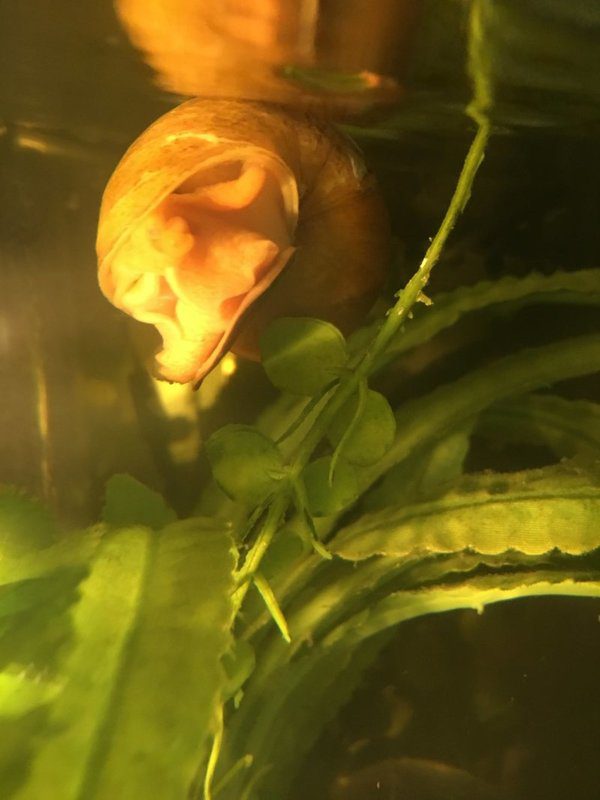
Why is mystery Snail floating?
- Air Trapped in Shell: Mystery snails have a trapdoor-like structure called the operculum that covers their shell opening. Sometimes, air can get trapped inside the shell, causing the snail to float. This is usually temporary and not a cause for concern. The snail should eventually release the trapped air and sink back to the bottom.
- Feeding or Grazing: Mystery snails often float to the water’s surface to feed on surface films or algae. This behavior is normal and usually temporary.
- Newly Introduced Snail: When a mystery snail is introduced to a new environment, it might float temporarily as it adjusts to the water conditions. This behavior can last for a short period as the snail acclimates.
- Shell Damage or Shell Erosion: If a mystery snail’s shell is damaged or eroded, it might affect its buoyancy. In some cases, shell damage can lead to air becoming trapped, causing the snail to float.
- Water Parameters: Poor water quality, fluctuations in water temperature, or imbalances in water chemistry could stress the snail and cause it to float. Make sure your tank’s water parameters are within the appropriate range for mystery snails.
- Illness or Stress: If your mystery snail is sick or stressed, it might exhibit abnormal behavior, including floating. Observe its overall condition and behavior for any signs of illness, such as changes in color, lethargy, or loss of appetite.
- Dead Snail: If a mystery snail has died, it might float at the water’s surface. As the body decomposes, gases can build up inside the shell, causing it to become buoyant. Check for other signs of death, such as a foul odor or lack of response to stimuli.
- Inadequate Calcium: Mystery snails require calcium for healthy shell growth. A lack of calcium can result in weak or thin shells, which might affect buoyancy.
If your mystery snail is floating, closely monitor its behavior and overall health. If the floating persists or is accompanied by other concerning signs, such as changes in color, foul odor, or prolonged inactivity, it’s a good idea to investigate further and address any potential issues. Regular water testing, proper diet, and a suitable tank environment are important factors in maintaining the well-being of your mystery snail.
How to tell if mystery snail eggs are fertile?
Determining whether mystery snail eggs are fertile can be challenging, as the process requires observation over time. Fertile eggs will develop into baby snails, while infertile eggs will remain unchanged or deteriorate. Here are some signs to help you determine if mystery snail eggs are fertile:
- Color Changes: Fertile mystery snail eggs might darken or change in color over time as the embryos inside develop. However, the color change can be subtle and may not always be a reliable indicator.
- Egg Development: Watch for changes in the appearance of the egg cluster. Over time, fertile eggs will become more opaque and less translucent as the embryos grow. Infertile eggs might remain clear and unchanged.
- Texture: As fertile mystery snail eggs develop, they might become more solid and less gelatinous. Infertile eggs could remain soft and jelly-like.
- Egg Movement: In some cases, you might notice tiny movements within the egg mass as the embryos develop. However, this can be difficult to observe, and not all eggs will exhibit this movement.
- Hatching: The most definitive sign of fertile eggs is the hatching of baby snails. If the eggs are fertile, you’ll eventually see small snails emerging from the egg clusters. This process usually takes around 2 to 4 weeks after the eggs are laid.
- Appearance of Eyespots: Some people report seeing small, dark spots that resemble eyes on the developing embryos inside the eggs. These spots can indicate that the eggs are fertile, but not all fertile eggs will display this feature.
- Egg Condition: Infertile eggs might become discolored, break down, or develop mold over time. Fertile eggs tend to maintain their structure and remain intact until they hatch.
Remember that it can be challenging to determine egg fertility with absolute certainty, and some signs might be subtle or not consistently present. If you’re interested in breeding mystery snails and are observing egg clusters, it’s a good practice to be patient and observe the eggs over time. If the eggs remain unchanged or start deteriorating, they might be infertile. If you notice baby snails hatching from the eggs, that’s a clear indication of fertility.
Keep in mind that mystery snails are often prolific breeders, and a single clutch of eggs can result in a significant number of baby snails. Be prepared to provide suitable care for the baby snails if you decide to allow them to hatch and grow in your aquarium.
Conclusion
In conclusion, mystery snails (Pomacea diffusa) are fascinating and popular freshwater aquarium inhabitants. Their unique appearance, behaviors, and ability to lay distinctive egg clutches make them a sought-after addition to aquariums. Proper care is essential to ensure their health and well-being:
- Tank Setup: Provide an appropriate tank size with smooth substrate, hiding places, and decorations. Live plants contribute to their well-being.
- Water Conditions: Maintain suitable water temperature, pH, hardness, and filtration. Regular water changes are crucial for good water quality.
- Feeding: Offer a balanced diet including plant matter, algae, and commercial snail food. Provide sources of calcium for shell health.
- Behavior: Be aware that mystery snails might exhibit periods of inactivity or floating, which can be normal. Ensure the snail responds to gentle stimuli.
- Eggs: Mystery snail eggs are laid above the waterline and resemble small bubbles. Observing egg development and hatching can indicate their fertility.
- Health Monitoring: Regularly observe their behavior, shell condition, and overall health. Address any signs of illness promptly.
- Tank Mates: Choose compatible tankmates and avoid aggressive or predatory species that might harm the snails.
- Genetics: Mystery snail colors, sizes, and growth rates can vary based on genetics.
Remember that mystery snails can live for 1 to 3 years, and their care requirements contribute to their longevity. Providing a suitable environment, proper diet, and attention to their well-being will help you enjoy the beauty and charm of these unique creatures in your aquarium. If you have specific questions or concerns about your mystery snails, don’t hesitate to seek advice from experienced hobbyists or professionals in the field.
